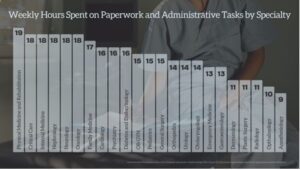The following is a guest article by Amanda Ford, Executive Vice President of Operations at ScribeAmerica
For care teams across the nation, provider burnout isn’t a buzzword, it’s a reality. And while some by-products of the pandemic are expected to disappear with time, burnout seems to be staying. If anything, the issue is getting worse. Increased workloads, difficult-to-navigate EHRs, documentation processes, administrative tasks, and more challenging work-life balance. Doctors are stuck spending more time working, but less time with patients.
The issue plagues every specialty in every state. And as providers grapple with burnout, more professionals are stepping away from healthcare altogether. Almost 3% of the healthcare workforce is resigning each month, accounting for 1.7 million people who quit last year. More than a quarter of those resignations are credited to burnout, reported Forbes.
The reality is that there is no pre-COVID world to return to. The stress of the pandemic exposed foundational cracks in the healthcare system that demand attention. Care teams must adapt the way they work, the way they engage with patients, and the way they embrace technology, to adjust to the new normal.
The New Pandemic
Burnout is used as a catch-all to describe physical and emotional exhaustion that results in poor performance, lack of engagement, and depression. Providers have named a long list of contributing factors that cause burnout, including; poor work-life balance, EHR and administrative fatigue resulting in long hours, overwhelming workloads, and difficulties interfacing with patients, among other issues. The pandemic exacerbated all of these issues and its impact is still resonating throughout healthcare. According to the AMA, nearly 63% of physicians now report experiencing symptoms of burnout at least once a week.
One of the greatest burdens to providers is documentation. Electronic health records were introduced to make documentation easier and more accessible. According to Becker’s, doctors spend an average of 15.5 hours a week on paperwork and administrative tasks. Hours spent scheduling and recording visits are not a part of the traditional workflow, forcing providers to rush through notes or complete them hours after encounters. With organizations focused on getting as many patients as possible through the door, work-life balance suffers for providers catching up on their documentation backlog. A 2019 article published in the American Journal of Medicine estimates that 37% of the time primary care providers spend with patients is actually spent interacting with EHRs.
 Too Many Clicks
Too Many Clicks
Burnout associated with electronic health systems is called “click fatigue”, where simple processes have become over-complicated because of how many “clicks” they require. To overcome this burden, many teams add an additional care provider to the room to help with documentation. Unfortunately, this only shifts the burden to another care team member. When a PA, Nurse, or other advanced practice professional takes on the additional role of note-taking, their workload increases and they suffer the same frustrations. While not just anyone can take medical notes, sidelining professionals into administrative roles wastes resources and does not allow them to work at the top of their license.
Expand and Conquer
Medical Scribes, on the other hand, are explicitly trained to navigate EHRs, taking medically accurate notes with skill and precision. By including team members whose primary function is to manage documentation, every care team member is left to operate at the top of their license, spending the bulk of their time on what they’re most qualified to do. With shortages and stressors rampant in healthcare, medical scribes are no longer a nice-to-have but a need-to-have.
Adding members to the care team ultimately saves time and money. The addition of scribes has shown a decrease in provider burnout, an increase in provider productivity, and an increase in revenue, even accounting for the investment in additional workforce. Check out the numbers:
- 27% decrease in burnout when physicians were paired with a scribe
- 10.5% increase in work RVUs per hour with the addition of scribes
- 26% revenue increase when utilizing scribes over three months
- 52% decrease in physician documentation time when a visit was scribed
Well-trained medical scribes make all the difference in how a care team operates. Expanding a team to include scribes boosts both productivity and morale. By letting experts handle documentation, providers are free to get back to what they do best; providing exceptional patient care.
 About Amanda Ford
About Amanda Ford
Amanda works closely with hospital partners and staffing groups across the country to deliver customized healthcare solutions at the point of care. She has worked in the medical scribe industry since 2002, beginning her career as a scribe leader and implementer. Her work has helped shape today’s modern medical scribe industry.













